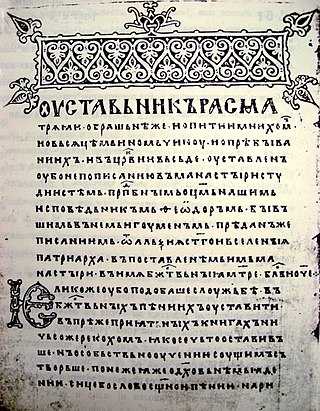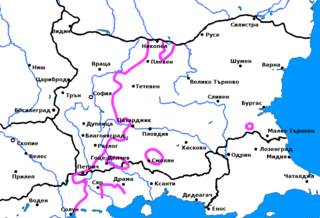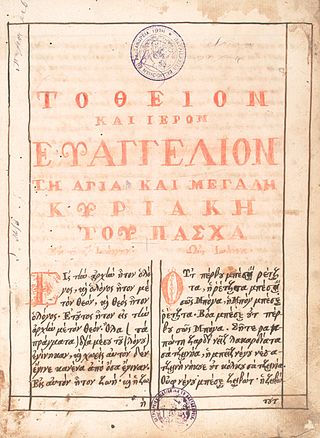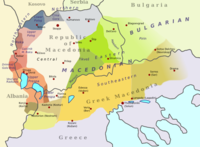
Macedonian is an Eastern South Slavic language. It is part of the Indo-European language family, and is one of the Slavic languages, which are part of a larger Balto-Slavic branch. Spoken as a first language by around two million people, it serves as the official language of North Macedonia. Most speakers can be found in the country and its diaspora, with a smaller number of speakers throughout the transnational region of Macedonia. Macedonian is also a recognized minority language in parts of Albania, Bosnia and Herzegovina, Romania, and Serbia and it is spoken by emigrant communities predominantly in Australia, Canada and the United States.

Old Church Slavonic or Old Slavonic is the first Slavic literary language.
The Balkan sprachbund or Balkan language area is an ensemble of areal features—similarities in grammar, syntax, vocabulary and phonology—among the languages of the Balkans. Several features are found across these languages though not all apply to every single language. The Balkan sprachbund is a prominent example of the sprachbund concept.

Bulgarian dialects are the regional varieties of the Bulgarian language, a South Slavic language. Bulgarian dialectology dates to the 1830s and the pioneering work of Neofit Rilski, Bolgarska gramatika. Other notable researchers in this field include Marin Drinov, Konstantin Josef Jireček, Lyubomir Miletich, Aleksandar Teodorov-Balan, Stoyko Stoykov.
The dialects of Macedonian comprise the Slavic dialects spoken in the Republic of North Macedonia as well as some varieties spoken in the wider geographic region of Macedonia. They are part of the dialect continuum of South Slavic languages that joins Macedonian with Bulgarian to the east and Torlakian to the north into the group of the Eastern South Slavic languages. The precise delimitation between these languages is fleeting and controversial.

The Skopska Crna Gora dialect is a member of the western subgroup of the northern group of dialects of Macedonian. The dialect is spoken in a small territory north of Skopje on the hem and at the foot of the mountain Skopska Crna Gora. The name of the dialect is derived from the name of the mountain because there are no cities in that territory. The Skopska Crna Gora dialect is spoken in the villages: Kučkovo, Orman, Volkovo, Novo Selo, Brazda, Gluvo, Čučer, Gornjane, Banjane, Mirkovci, Kučevište, Pobožje, Brodec, Ljubanci, Ljuboten, Raštak, Gorno Orizari, Radišani, Bulačani, Cresevo and Stajkovci.
The term Maleševo-Pirin or Maleshevo-Pirin or Pirin-Maleshevo dialect is used in South Slavic linguistics to refer to a group of related varieties that are spoken on both sides of the border of Bulgaria and the Republic of North Macedonia. Some linguists treat them as dialects of the Bulgarian language, while Victor Friedman views them as part of Macedonian. According to some authors, they are linguistically transitional between the two national languages, Bulgarian and Macedonian and form part of the larger dialect continuum between them. The dialect group is named after the mountain ranges of Pirin in Bulgaria and Maleševo in Macedonia. When referring specifically to the dialects on the Bulgarian side, the term Petrich-Blagoevgrad dialect, after the two major towns in the area, is also used.

The Ser-Drama-Lagadin-Nevrokop dialect is a dialect currently treated both in the contexts of the southeastern group of Bulgarian dialects and the southeastern subgroup of dialects of the Macedonian. Prior to the codification of standard Macedonian in 1945, the dialects of Macedonia were classified as Bulgarian. The dialect is dynamic and is well known for the shortening of the words, and also characterised by the excessive use of for the Proto-Slavic yat even in cases where standard Bulgarian has, a feature which is typical for a number of dialects spoken in southern and southwestern Bulgaria . The Ser-Drama-Lagadin-Nevrokop dialect is closely related to the neighbouring dialects. It is closer to all Eastern Bulgarian dialects than to all Western. Macedonian shares much less features with the dialect than it does with the Maleševo-Pirin dialect of Macedonian and Bulgarian. Some Bulgarian dialects are more similar to Macedonian than the Ser-Nevrokop dialect, the Samokov dialect shares more features with Macedonian than both the Ser-Nevrokop and the Pirin-Malasevo dialects do, even though it is not considered a Macedonian dialect, the most of the western Bulgarian dialects and the Smolyan dialect share more similarities with Macedonian than the Ser dialect does. The Samokov dialect, most remarkably, shares with Macedonian and the Maleševo-Pirin dialect—the "to be" verb for future tense—"ke", which in contrast is "shte" in the Ser-Nevrokop dialect and in the Bulgarian language. The Yat border passes through the Maleševo-Pirin dialect and divides it on such a way that in the northern area of the dialect the yat is pronounced "e" and in the south—"ya". In the Ser-Nevrokop dialect the yat is pronounced in most places "ya", therefore the city of Serres, after which the dialect is named, is called "Syar" by the locals, as opposed to "Ser" in Macedonian. The first person singular is as in Bulgarian, ending with "a" or "am" as opposed to the constant "am" in Macedonian and the Bulgarian Smolyan dialect. The words for man -"m'zh" and for a dream "s'n" are as in Bulgarian, unlike the Macedonian "mazh" and "son". The words for night and tear—"nosht" and "s'lza" are as the Bulgarian, unlike the Macedonian "nok" and "solza".

The Moesian dialects are a group of closely related dialects of the Bulgarian language, part of the Eastern Bulgarian dialects. The Moesian dialects are spoken in northeastern Bulgaria and in the regions of Karnobat, Aytos, Burgas and Yambol in southern Bulgaria. However, due to the mass population movements that affected eastern Bulgaria during the 19th and the beginning of the 20th century, nowadays, there are very few areas where only Moesian is spoken. In most areas, and especially in southern Bulgaria and Dobruja, Moesian speakers are mixed with speakers speaking Balkan dialects. As a result of this and also due to the influence of the literary language, most features of the Moesian dialects have given way to features typical for the Balkan dialects.

The Vidin-Lom dialect is a Bulgarian dialect spoken in the regions of Vidin and Lom and partially in the regions of Berkovitsa and Montana in northwestern Bulgaria. The dialect is part of the Northwestern Bulgarian dialects. The most significant feature of the dialect, as in all Western Bulgarian dialects, is the pronunciation of Old Church Slavonic ѣ (yat) only as instead of formal and Eastern Bulgarian я/е (/) – бел/бели instead of бял/бели.

The Balkan dialects are the most extensive group of dialects of the Bulgarian language, covering almost half of the present-day territory of Bulgaria. Their range includes north-central Bulgaria and most of the Bulgarian part of Thrace, excluding the Rhodopes, the region of Haskovo and Strandzha. As a result of the mass population movements that affected eastern Bulgaria during the 19th and the beginning of the 20th century, the Balkan dialects are now spoken also in vast areas of northeastern Bulgaria, especially the regions of Dobrich and Varna. The most significant feature of the dialects, as in most Eastern Bulgarian dialects, is the pronunciation of Old Church Slavonic ѣ (yat) as or, depending on the character of the following syllable. The Balkan dialects, and in particular, the Central Balkan dialect, lie at the foundation of formal Bulgarian. However, they are not identical to the standard language because many of its features derive from the Western Bulgarian dialects, including the Macedonian dialects, or are a compromise between Eastern and Western standard.

The Rup dialects, or the Southeastern dialects, are a group of Bulgarian dialects located east of the yat boundary, thus being part of the Eastern Bulgarian dialects. The range of the Rup dialects includes the southern part of Thrace, i.e. Strandzha, the region of Haskovo, the Rhodopes and the eastern half of Pirin Macedonia.
The Smolyan dialect or Central Rhodope dialect is a Bulgarian dialect of the Rhodopean group of the Rup dialects. Its range includes most of the Central Rhodopes, i.e. the region of Smolyan. Its immediate neighbours are the Rhodopean Hvoyna dialect to the north, the Serres-Nevrokop dialect and the Razlog dialect to the west and the Turkish dialects of the Turkish population in the Eastern Rhodopes. To the south, the Smolyan dialect crosses the Greek-Bulgarian border and is spoken by much of the Muslim Bulgarian (Pomak) population in Western Thrace. As a result of the rugged mountainous terrain and the century-long isolation of the region from the rest of the country, the Smolyan dialect is the most idiosyncratic of all Bulgarian dialects and is not readily understandable even for its immediate neighbours.

The Southwestern Bulgarian dialects are a group of Bulgarian dialects which are located west of the yat boundary and are part of the Western Bulgarian dialects. The range of the Southwestern dialects on the territory of Bulgaria includes most of west central and southwestern Bulgaria. The Southwestern dialects border on the Northwestern dialects to the north, the Transitional dialects to the northwest and the Balkan dialects and the Rup dialects to the northeast and southeast, respectively. If the Macedonian language is regarded as a third literary form of Modern Bulgarian, then the Southwestern dialects extend west and southwest to include the Slavic dialects in Vardar Macedonia and the western half of Greek Macedonia. Should the Macedonian language be counted as a separate language, then the southernmost dialect of the group, the Blagoevgrad-Petrich or Pirin dialect, along with the corresponding variety on the Macedonian side of the border, the Maleshevo dialect, constitute a transitional dialect between Bulgarian and Macedonian. A defining characteristic of the Southwestern dialects is the gradual transition from one dialect to another, as well as to dialects which belong to other dialectal groups. For example, the Dupnitsa dialect is transitional to both the Samokov dialect and the Blagoevgrad-Petrich dialect, the Botevgrad dialect is transitional to the Eastern Bulgarian Balkan dialects, and especially to the Pirdop dialect, etc. etc.
The Samokov dialect is a Bulgarian dialect, member of the Southwestern Bulgarian dialects, which is spoken in the region of Samokov in central western Bulgaria. Its immediate neighbours are the Sofia dialect and Elin Pelin dialect to the north, the Ihtiman dialect to the east, the Dupnitsa dialect to the west and the Razlog dialect to the south.
This article discusses the phonological system of the Bulgarian language.

The history of Bible translations into Macedonian is connected in its early years with the history of Bible translations into Bulgarian. After the codification of Macedonian in 1945, in 1952 a liturgical edition of the four Gospels was printed as the first official translation into standard Macedonian.

The Nestram-Kostenar dialect is a Macedonian Slavic dialect spoken in parts of northwestern Greece, in the area around the village of Nestorio (Nestram) and the area known as Kostenarija, which encompasses most of the Nestorio municipality as well as in the Akrites region. There are also speakers in the adjacent Devoll District of Albania.

The Kostur dialect, is a member of the Southwestern subgroup of the Southeastern group of dialects of the Macedonian language. This dialect is mainly spoken in and around the town of Kastoria, known locally in Macedonian as Kostur, and in the surrounding Korešta region, which encompasses most of the area to the northwest of the town. The Kostur dialect is also partially spoken in Albania, most notably in Bilisht and the village of Vërnik (Vrabnik). The dialect is partially preserved among the ″people of Bulgarian origin in Mustafapaşa and Cemilköy, Turkey, descending from the village of Agios Antonios (Zhèrveni) in Kostur region ″.
The Eastern South Slavic dialects form the eastern subgroup of the South Slavic languages. They are spoken mostly in Bulgaria and North Macedonia, and adjacent areas in the neighbouring countries. They form the so-called Balkan Slavic linguistic area, which encompasses the southeastern part of the dialect continuum of South Slavic.









